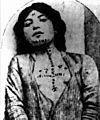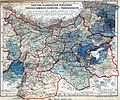Armenian Genocide facts for kids
Quick facts for kids Armenian genocide |
|
|---|---|
| Part of World War I | |

Column of Armenian deportees guarded by gendarmes in Harput Vilayet
|
|
| Location | Ottoman Empire |
| Date | 1915–1917 |
| Target | Ottoman Armenians |
|
Attack type
|
Genocide, death march, forced Islamization |
| Deaths | 600,000–1.5 million |
| Perpetrators | Committee of Union and Progress |
| Trials | Ottoman Special Military Tribunal |
The Armenian genocide was the forced deportation and the killings of most Armenians from 1915 to 1917 in the Ottoman Empire, which was ruled by the Young Turks.
Contents
Planning
In November 1914, the Ottoman Empire joined World War I on the side of the Central Powers. İsmail Enver, the Minister of War, launched a disastrous military campaign against Russian forces in the Caucasus in the hope of capturing Baku. His forces were routed at the Battle of Sarikamis, and many of his men froze to death.
Returning to Istanbul, Enver largely blamed the Armenians living in the region for actively siding with the Russians. Despite the tensions, the Armenians had thrived under Ottoman rule. Most Armenians were better educated and wealthier than their Turkish counterparts, who were jealous of their success. The resentment was fuelled by suspicions that the Christian Armenians would support fellow Christian governments, especially Russia, which shared an unstable border with the Ottoman Empire, as opposed to the Muslim Ottoman caliphate.
In 1914, the Ottoman War Office had already begun a propaganda drive to present Armenians as a liability and a threat to the Ottomans' security. The Ottoman government, moving quickly, arrested an estimated 250 Armenian intellectuals on the night of 24 April 1915. The acts of genocide against the Armenians continued for nine years until 1922, with around 388,000 Armenians remaining.
The massacres of Armenians in 1894, 1895, 1896 and 1909 were still fresh in their minds.
Acts committed by Turks
In the beginning, around 1915-1916, Armenians were kicked out of their homes, which were claimed by Turks. During a Turkification campaign, the government squads kidnapped children, converted them to Islam, and gave them to Turkish families. In some places, they forced women to join Turkish “harems” or serve as slaves. Muslim families moved into the homes of deported Armenians and seized their property.
At the same time, the Turks created a 'Special Organization', which in turn organized 'killing squads' or 'butcher battalions' to carry out, as one officer put it, “the liquidation of the Christian elements”. The killing squads were often made up of murderers and other ex-convicts.
Foreign accounts
"I am confident that the whole history of the human race contains no such horrible episode as this. The great massacres and persecutions of the past seem almost insignificant when compared with the sufferings of the Armenian race in 1915." Henry Morgenthau, American ambassador to the Ottoman Empire, 1913-1916. -Henry Morgenthau
Denial of killings
Guenter Lewy claims in his book,The Armenian Massacres in Ottoman Turkey: A Disputed Genocide, that there is not enough evidence of the Young Turk regime organizing the killings of Armenians in the Ottoman Empire. According to Lewy, even though their fate in World War I proved tragic, it was not a "real" genocide because "there were no centrally organized and state-sponsored premeditation and genocidal intention".
A major obstacle for the wider recognition of the genocide in the world is the official position of Turkey, which states that there was no systematic attempt to annihilate the Armenian population and that the 1915 massacres happened because of the Tehcir Law and the war. In December 2008, a group of Turkish scholars launched an online petition for people who wanted to apologize for what happened. The people who created the petition failed to use the word "genocide" but used "the Great Catastrophe" regarding the event. Many Turks viewed the Armenians as a threat to the Ottoman Empire in a time of war and argued that people of various ethnicities were killed during the violence. Turkey and its leaders fear that recognizing the word "genocide" could cost considerable sums of money in reparations, as well as public embarrassment.
International recognition
In response to continuing denial by the Turkish state, many Armenian diaspora activists have lobbied for formal recognition of the Armenian genocide, an effort that has become a central concern of the Armenian diaspora. From the 1970s onwards, many countries avoided recognition to preserve good relations with Turkey. As of 2022[update], 31 countries have recognized the genocide, along with Pope Francis and the European Parliament.
Cultural depictions
After meeting Armenian survivors in the Middle East, Austrian–Jewish writer Franz Werfel wrote The Forty Days of Musa Dagh (1933), a fictionalized retelling of the successful Armenian uprising in Musa Dagh, as a warning of the dangers of Nazism. According to Ihrig, the book is among the most important works of twentieth-century literature to address genocide and "is still considered essential reading for Armenians worldwide". The genocide became a central theme in English-language Armenian-American literature. The first film about the Armenian genocide, Ravished Armenia, was released in 1919 as a fundraiser for Near East Relief, based on the survival story of Aurora Mardiganian, who played herself. Since then more films about the genocide have been made, although it took several decades for any of them to reach a mass-market audience. The abstract expressionist paintings of Arshile Gorky were influenced by his experience of the genocide. More than 200 memorials have been erected in 32 countries to commemorate the event.
Gallery
-
The Armenian quarter of Adana after the 1909 massacres
-
Çankaya Mansion, the official residence of the president of Turkey, was confiscated from Ohannes Kasabian, an Armenian businessman, in 1915.
-
Aerial view of the Armenian Genocide memorial complex on a hill above Yerevan
Related pages
- Pontic Greek Genocide
- Adana massacre
- Hamidian massacres
See also
 In Spanish: Genocidio armenio para niños
In Spanish: Genocidio armenio para niños

















